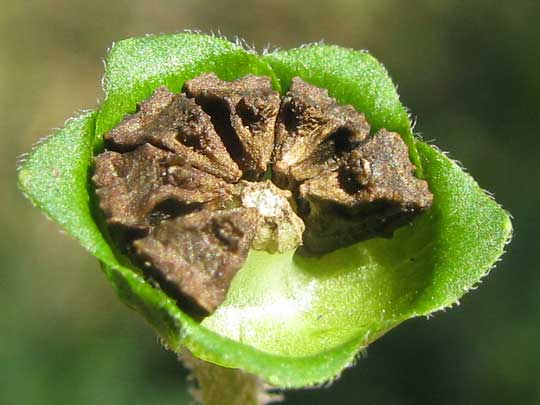Excerpts from Jim Conrad's
Naturalist Newsletter
from the December 20, 2009 Newsletter issued from Hacienda Chichen Resort beside Chichén Itzá Ruins, central Yucatán, MÉXICO; limestone bedrock, elevation ~39m (~128ft), ~N20.676°, ~W88.569°
BUTTER DAISIES
Along roadsides here at the beginning of the dry season a certain yellow-blossomed composite often grows so thickly and blooms so robustly that during most of the day when the sunlight is almost too bright and heavy to deal with, you just have to pause and look at them. Sometimes for miles almost pure stands of them go on and on, reminding a Northerner how in late summer sometimes up there Spanish Needles -- also yellow-flowered composites -- put on similar shows. You can see a sample patch of their inch-wide heads below:

They're Butter Daisies, MELAMPODIUM DIVARICATUM, and they have an accepted English name because they live in southern Florida as introduced "weeds." Mainly, however, they're distributed from Mexico and the Caribbean into South America.
Butter Daisy blossoms are unusual, but to appreciate what's special about them you need to know what a "normal" Composite-Family member is like. You can refresh your memory about basic composite anatomy at www.backyardnature.net/fl_comps.htm.
First, you can see a single flower head below:

There's not much unusual there. The center is occupied by dozens of crammed-together disk flowers and these are surrounded by petal-like ray flowers. But take a look at what you see when a head is broken open, below.

Notice that the disk flowers in the center have no developing fruits, or achenes, at their bases. That's because Butter Daisy's disk flowers are sterile -- only its ray flowers produce fruits. That's a little unusual among composites, but not very.
But what are those pale green, wedge-shaped things forming a circle just beneath the ray flowers? They are maturing fruits, or achenes, each produced by a single ray flower. A few composite genera have their achenes produced only by ray flowers, but very few of those have wedge-shaped achenes.
There's another unusual thing about flowers in this genus, as shown prettily below:

In "normal" composite flowers the green bracts at the flowerhead's bottom -- the involucral bracts -- are numerous and overlap one another like shingles on a roof. Melampodium bracts are few and ours are fused together at their bases, forming a shallow bowl. You can see the resulting amazing structure below.

In the picture several achenes have fallen out. I suspect that this pie-plate design explains why the individual flower heads stand atop long, slender stems, or peduncles: Atop such limber stems the heads are likely to swing exaggeratedly in the wind or when an animal moves through them, tossing pie-slice achenes from the pan. Everything seems designed to further fruit dispersal.